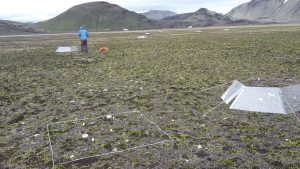Appraising the effects of warming on liverwort biocrust
Anthelia liverwort covers large areas in the Icelandic highlands where it lives in a community of other minute organisms forming a greyish biological soil crust (biocrust). Anthelia liverwort habitats and other biocrust areas of highlands and mountains in Iceland are now being investigated by scientists from the University of Iceland with support from the Icelandic Research Fund.
Part of the project entails appraising the effects of warming by setting up transparent open top chambers (OTCs). There is good long term experience with such OTCs at Þingvelir, Auðkúluheiði and many other sites in the Arctic. The mean temperatures within the OTCs increases by nearly two degrees Celsius, simulating anticipated climate change. This experimental setup is designed to help estimate predicted changes in a habitat widespread in Icelandic highlands and in many other places.
In the last two years several sites in south and west Iceland have been explored for suitability. The area at Fjallabak south of Löðmundarvatn appears particularly suitable for OTC warming experiments due to accessibility and because it is level. It is uncommon to find liverwort biocrust in areas with both these attributes. Therefore we sought formal permission from relevant authorities to set up the OTC experiment under these favorable conditions.


The experiment involves setting up eight OTCs, each about 40 cm high enclosing about one square meter. There is a small temperature and light recorder in each OTC and in a control plot just beside it. Small samples are also taken for analysis of biomass, carbon, nitrogen etc. The enclosures are transparent and at least 100 meters away from the road so they have minimum visibility. Experience from other such setups shows that they do not endanger animals such as sheep and birds.
The experimental plots will be assessed early and late summer for at least three years (up to ten years), repaired as needed and summaries of observations compiled and made available to scientists and the public.
Ólafur S. Andrésson
Professor of Genetics, Faculty of Life and Environmental Sciences, University of Iceland osa@hi.is tel. 525 4627 and 864 2149
Other people involved with this project: Dr. Alejandro Salazar Villegas salazar@hi.is, professor Ingibjörg Svala Jónsdóttir isj@hi.is, Rúna Björk Smáradóttir rbs1@hi.is, Petra Landmark Guðmundsdóttir plg1@hi.is, Clara Vasquez-Mejia claravasquezmejia@gmail.com
